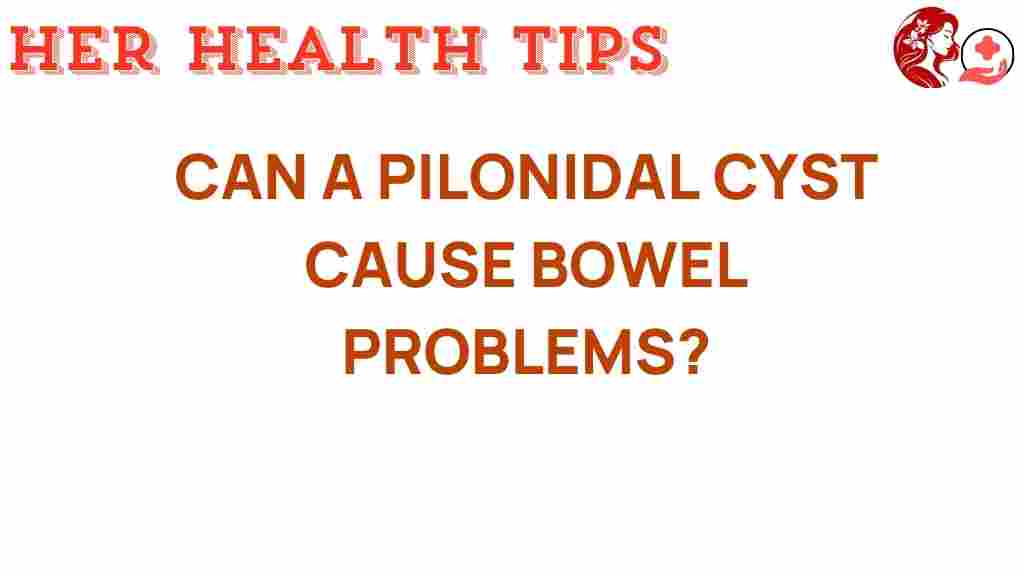Unraveling the Mystery: Can a Pilonidal Cyst Cause Bowel Problems?
Pilonidal cysts are a common yet often misunderstood condition that can lead to various complications if left untreated. One of the pressing questions surrounding this issue is whether a pilonidal cyst can cause bowel problems. In this article, we will delve into the symptoms, diagnosis, treatment options, and potential complications of pilonidal cysts, as well as their relationship with bowel issues.
What is a Pilonidal Cyst?
A pilonidal cyst is a small sac that forms under the skin, typically at the base of the spine. It often contains hair, skin debris, and sometimes pus. Pilonidal cysts are most commonly found in young adults and can occur due to various factors such as:
- Excessive sitting
- Obesity
- Hairy skin
- Trauma to the area
While the primary issue caused by a pilonidal cyst is localized pain and discomfort, understanding whether it can lead to bowel problems is crucial for effective management.
Symptoms of Pilonidal Cysts
Recognizing the symptoms of a pilonidal cyst is vital for early diagnosis and treatment. Common symptoms include:
- Swelling or lump near the tailbone
- Redness and inflammation of the skin
- Pain, especially when sitting or moving
- Drainage of pus or blood from the cyst
- Occasional fever if infection occurs
These symptoms can vary in intensity and may worsen if the cyst becomes infected. It’s essential to consult a healthcare professional if you experience any of these symptoms.
Can a Pilonidal Cyst Cause Bowel Problems?
The relationship between pilonidal cysts and bowel problems is not direct; however, some patients may experience discomfort that could be mistaken for bowel issues. Here’s a closer look at how they might be connected:
- Referred Pain: Pain from a pilonidal cyst can sometimes radiate to the lower abdomen or pelvic area, leading individuals to believe they are experiencing bowel problems.
- Infection and Inflammation: If a pilonidal cyst becomes infected, the surrounding tissues can become inflamed, which may cause discomfort during bowel movements.
- Psychological Factors: Chronic pain from a pilonidal cyst might lead to increased anxiety or stress, which can affect bowel habits and cause symptoms such as constipation or diarrhea.
While a pilonidal cyst does not directly cause bowel problems, it can contribute to discomfort that mimics these issues. Therefore, it’s essential to address the cyst to alleviate any associated pain.
Diagnosis of Pilonidal Cysts
Diagnosing a pilonidal cyst typically involves a physical examination by a healthcare provider. The doctor will look for:
- Visible swelling or lumps in the sacrococcygeal area
- Signs of inflammation or infection
- Drainage from the cyst
In some cases, imaging tests such as ultrasound or MRI may be necessary to rule out other conditions or complications.
Treatment Options for Pilonidal Cysts
Treatment for pilonidal cysts depends on the severity of symptoms and whether there is any infection. Here are common treatment options:
- Conservative Treatment: For mild cases, conservative measures such as warm compresses, proper hygiene, and pain relievers (like ibuprofen) can help manage symptoms.
- Antibiotics: If an infection is present, antibiotics may be prescribed to help clear the infection.
- Surgical Intervention: In cases where the cyst is recurrent or causing significant pain, surgical removal is often recommended. This can involve:
- Incision and drainage of the cyst
- Excision of the cyst along with surrounding tissue
Post-surgery, proper care is essential to prevent recurrence and manage any potential complications.
Potential Complications of Pilonidal Cysts
While pilonidal cysts are usually not life-threatening, they can lead to several complications if untreated:
- Chronic Infection: Untreated cysts can become infected, leading to abscess formation and severe pain.
- Recurrence: Pilonidal cysts can recur, especially if the cyst is not completely excised.
- Fistula Formation: In some cases, an infected cyst may develop a fistula, creating an abnormal connection between the cyst and the skin surface.
Being aware of these complications emphasizes the importance of seeking timely healthcare when symptoms arise.
Step-by-Step Guide to Managing Pilonidal Cysts
If you suspect you have a pilonidal cyst, follow these steps to manage the condition effectively:
- Consult a Healthcare Professional: If you notice symptoms like swelling or pain near the tailbone, seek medical advice.
- Undergo Diagnosis: Allow your healthcare provider to perform a physical examination and, if necessary, imaging tests.
- Follow Recommended Treatment: Depending on the severity of your cyst, adhere to the treatment plan suggested by your doctor.
- Practice Good Hygiene: Keep the area clean and dry to prevent infections.
- Monitor Symptoms: Keep track of any changes in your symptoms and report them to your healthcare provider.
Troubleshooting Tips for Managing Pain
If you are experiencing pain due to a pilonidal cyst, consider these troubleshooting tips:
- Use Warm Compresses: Applying warm compresses to the affected area can help reduce pain and swelling.
- Take Over-the-Counter Pain Relievers: Nonsteroidal anti-inflammatory drugs (NSAIDs) can help manage pain and inflammation.
- Avoid Prolonged Sitting: If possible, avoid sitting for long periods, as this can exacerbate pain.
- Wear Loose Clothing: Opt for loose-fitting clothes to reduce friction in the area.
Implementing these tips can provide temporary relief while you seek medical attention.
Conclusion
In conclusion, while a pilonidal cyst does not directly cause bowel problems, it can lead to symptoms that may mimic such issues. Understanding the symptoms, diagnosis, treatment options, and potential complications is crucial for effective management. If you experience persistent pain or discomfort near the tailbone, consult a healthcare professional for a thorough evaluation and appropriate treatment.
For more information on pilonidal cysts and their treatment, you can visit this resource. Additionally, if you are looking for healthcare providers specializing in this condition, check out this link for assistance.
This article is in the category Conditions and created by HerHealthTips Team
